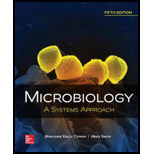
Concept explainers
Which of the following is/are not essential to carry out the polymerase chain reaction?
- a. primers
- b. DNA polymerase
- c. gel electrophoresis
- d. high temperature
Introduction:
PCR is a technique used to replicate and produce several copies of DNA. PCR has a wide application in research, medicine, agriculture, and many other fields.
Answer to Problem 1MCQ
Correct answer:
Gel electrophoresis is not essential to carry out polymerase chain reaction. Therefore, option (c) is correct.
Option (c) is given as “gel electrophoresis”.
Explanation of Solution
Justify reason for the correct statement:
PCR is a technique used to amplify DNA molecules. This technique involves three steps: denaturation, annealing, and extension. In denaturation, double stranded DNA is heated athigh temperature
After polymerase chain reaction, the resulted fragments are run into gel electrophoresis. Gel electrophoresis is used to separate DNA fragments according to the molecular weight. Thus, gel electrophoresis is not essential to carry out PCR.
Hence, option (c) is correct.
Justify reasons for the incorrect statements:
Option (a) is given as “primers”.
Primers are essential to carry out the polymerase chain reaction. Hence, it is a wrong answer.
Option (b) is given as “DNA polymerase”.
DNA polymerase is important to synthesize DNA fragment. Hence, it is a wrong answer.
Option (d) is given as “high temperature”.
High temperature is required for denaturation of DNA. Hence, it is a wrong answer.
Hence, options (a),(b), and(d) are incorrect.
Gel electrophoresis technique is used after the PCR reaction. Gel electrophoresis technique is used to separate the amplified DNA fragments.
Want to see more full solutions like this?
Chapter 10 Solutions
Microbiology: A Systems Approach
- Give examples of fat soluble and non-fat soluble hormonesarrow_forwardJust click view full document and register so you can see the whole document. how do i access this. following from the previous question; https://www.bartleby.com/questions-and-answers/hi-hi-with-this-unit-assessment-psy4406-tp4-report-assessment-material-case-stydu-ms-alecia-moore.-o/5e09906a-5101-4297-a8f7-49449b0bb5a7. on Google this image comes up and i have signed/ payed for the service and unable to access the full document. are you able to copy and past to this response. please see the screenshot from google page. unfortunality its not allowing me attch the image can you please show me the mathmetic calculation/ workout for the reult sectionarrow_forwardIn tabular form, differentiate between reversible and irreversible cell injury.arrow_forward
- 1.)What cross will result in half homozygous dominant offspring and half heterozygous offspring? 2.) What cross will result in all heterozygous offspring?arrow_forward1.Steroids like testosterone and estrogen are nonpolar and large (~18 carbons). Steroids diffuse through membranes without transporters. Compare and contrast the remaining substances and circle the three substances that can diffuse through a membrane the fastest, without a transporter. Put a square around the other substance that can also diffuse through a membrane (1000x slower but also without a transporter). Molecule Steroid H+ CO₂ Glucose (C6H12O6) H₂O Na+ N₂ Size (Small/Big) Big Nonpolar/Polar/ Nonpolar lonizedarrow_forwardwhat are the answer from the bookarrow_forward
- what is lung cancer why plants removes liquid water intead water vapoursarrow_forward*Example 2: Tracing the path of an autosomal dominant trait Trait: Neurofibromatosis Forms of the trait: The dominant form is neurofibromatosis, caused by the production of an abnormal form of the protein neurofibromin. Affected individuals show spots of abnormal skin pigmentation and non-cancerous tumors that can interfere with the nervous system and cause blindness. Some tumors can convert to a cancerous form. i The recessive form is a normal protein - in other words, no neurofibromatosis.moovi A typical pedigree for a family that carries neurofibromatosis is shown below. Note that carriers are not indicated with half-colored shapes in this chart. Use the letter "N" to indicate the dominant neurofibromatosis allele, and the letter "n" for the normal allele. Nn nn nn 2 nn Nn A 3 N-arrow_forwardI want to be a super nutrition guy what u guys like recommend mearrow_forward
- Essentials of Pharmacology for Health ProfessionsNursingISBN:9781305441620Author:WOODROWPublisher:Cengage
 Concepts of BiologyBiologyISBN:9781938168116Author:Samantha Fowler, Rebecca Roush, James WisePublisher:OpenStax College
Concepts of BiologyBiologyISBN:9781938168116Author:Samantha Fowler, Rebecca Roush, James WisePublisher:OpenStax College
 Human Heredity: Principles and Issues (MindTap Co...BiologyISBN:9781305251052Author:Michael CummingsPublisher:Cengage Learning
Human Heredity: Principles and Issues (MindTap Co...BiologyISBN:9781305251052Author:Michael CummingsPublisher:Cengage Learning Biology Today and Tomorrow without Physiology (Mi...BiologyISBN:9781305117396Author:Cecie Starr, Christine Evers, Lisa StarrPublisher:Cengage Learning
Biology Today and Tomorrow without Physiology (Mi...BiologyISBN:9781305117396Author:Cecie Starr, Christine Evers, Lisa StarrPublisher:Cengage Learning Biology: The Dynamic Science (MindTap Course List)BiologyISBN:9781305389892Author:Peter J. Russell, Paul E. Hertz, Beverly McMillanPublisher:Cengage Learning
Biology: The Dynamic Science (MindTap Course List)BiologyISBN:9781305389892Author:Peter J. Russell, Paul E. Hertz, Beverly McMillanPublisher:Cengage Learning





